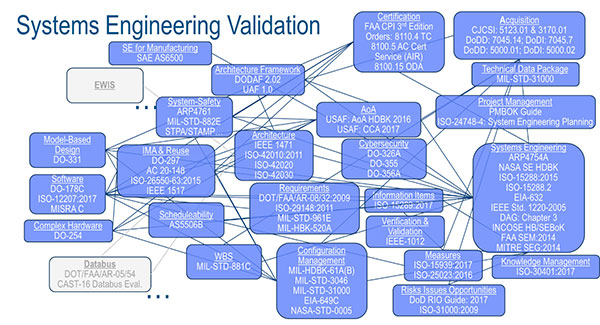
Start with your requirements set at the beginning, which is the standard performance set of requirements. The next set of requirements gets into system safety, where you look at failure modes. Image courtesy of Siemens Digital Industries Software.
Latest News
May 5, 2023
Modeling and simulation are notable modern engineering design advancements. Their merits enable engineers to reduce risk and bring efficiency to otherwise complex systems and situations.
Use of modeling and simulation provides the ability to carefully design complex aircraft, sophisticated ship propulsion, mechanical systems of all kinds, and myriad other systems that are complex and daunting on the engineer’s drawing board. Along with this capability, model-based systems engineering (MBSE) leverages modeling to support system requirements, design and analysis. This approach can make the design of complex systems more efficient, consistent and effective.
MBSE’s benefits extend beyond helping engineers build out the required system architecture. It’s becoming quite effective to achieve desired results and outcomes.
“We’re going to continue to see a lot of growth in the area of systems engineering and MBSE well beyond just architecture development, and well beyond just system modeling,” says Dale Tutt, vice president of industry strategy at Siemens Digital Industries Software. “Companies are going to embrace it to really drive the outcomes for their entire product development lifecycle.
“When they’re developing new products during early concept design, they’re going to be using those architectures and requirements that come out of that activity and the simulations of models to drive the downstream activities in design, development, testing [and] manufacturing, so that they can start to run their programs more effectively,” Tutt says.
Integral to Digital Transformations
In a larger sense, MBSE is the impetus behind the digital transformations currently underway at so many organizations as they come to fully embrace Industry 4.0 and put the technology to work.
“For engineering-driven environments, MBSE is generally regarded as a critical enabler of digital transformation,” says Garrett Thurston, global program digital transformation senior director, Dassault Systèmes. “Even the Department of Defense (DoD) and branches of the military are discovering how a digitally enabled, model-based approach can vastly improve the execution of product design, development and sustainment, and thus deliver increased value to the acquisition of new systems.

MBSE at scale needs value network-level collaboration. There should be a connection of System Engineering, Specialty Engineering, Design Disciplines to the Enterprise, Extended Enterprise/Value Network Data, Information, Knowledge, Decision Making and Implementation Infrastructure. Image courtesy of Dassault Systèmes.
“What MBSE brings to the table is a common communication language that facilitates managing both complexity and scale,” Thurston adds.
Jim Tung is a MathWorks fellow with MathWorks. He observes that customers continue to evolve how they perform their systems engineering activities, such as managing requirements, defining architectures and interfaces, and performing trade studies.
“They are relying less on traditional approaches using documents, spreadsheets and Visio or PowerPoint diagrams,” Tung says, instead using models. “If one team is doing both the systems engineering and the detailed design and implementation, they might use a modeling environment like Simulink that spans design, implementation and verification. More complex projects often require additional processes to manage the negotiations and address the requirements across multiple stakeholders.” He says in those cases, teams will typically use SysML or a similar tool.
But Tung emphasizes that MBSE is, at its core, a transition from documents to descriptive models. “The various SysML diagrams provide effective support for many systems engineering design challenges,” Tung says. “The diagrams are standardized and widely known, which helps engineers communicate their ideas more easily and accurately. The content underlying the diagrams is structured and integrated, which makes the model more maintainable.”
Systems engineers want to use models to predict the behavior of the system modeled, says Alan Moore, an architecture modeling specialist at MathWorks, and a systems engineering technical lead and language architect for SysML 1.
“In this area, SysML is acknowledged to be weak, because the semantics of the SysML language are patchy and—more important—have typically not been well-supported by SysML tools,” says Moore. “This means they have to move out of SysML tools and into other simulation and analysis tools. That is one of several key reasons that customers look to System Composer to connect their MBSE models to MATLAB and Simulink models.”
In addition, Moore says he sees a growing use of system-development modeling tools in agile workflows like DevOps, which are different from a “top-down” approach where SysML is often employed. “We also see companies establishing a digital thread between their artifacts (including models), with that digital thread driving more automation in the development process, for example, continuous integration,” Moore explains.
He continues, “This has created challenges for MBSE approaches. Models used to automatically generate code and automatically test for regressions have a clear role and value in agile and DevOps workflows. Traditional MBSE artifacts are undoubtedly a valuable aid to the creative design process, but determining their role and measuring their value in DevOps is often difficult.”
Holistic Approaches to Systems Design
Siemens’ Tutt says many get bitten by the notion that it’s not just about individual system modeling tools, but it must be part of a larger, more holistic design approach and process.
“It’s a holistic approach towards tools but also processes and people,” Tutt says. “When you think about the challenges that companies face, they go out and they buy tools but you have to have a good process that helps manage your workflows in an efficient manner to actually use those tools in the right way and to manage that data in the right way as you go throughout the entire development process, or the program.”

Growth is expected in systems engineering and MBSE, beyond architecture development, and well beyond system modeling. Image courtesy of Siemens Digital Industries Software, U.S.
Tutt emphasizes how it is important to think about the tools, your processes and the people. People have to learn how to adopt the tools and a new process.
“There’s a bit of organizational change management [people] have to go through when you start to implement these robust systems engineering processes. My own personal experience on this is that as we were trying to implement new systems engineering processes and do a better job of documenting requirements, and then using that information [as it] actually flow[s] down through the entire design of the product, that people said, ‘I really know how to do this design stuff. I’ve been designing airplanes for 20 years. Why do I need to go do this?’” Tutt says.
Tutt also says it’s the same thinking with automotive design. “People have been doing this for a long time,” he adds. “They know how to design these products and so they’re looking at new processes as, ‘Why must I do all this other work? You’re just adding a bunch of overhead and it’s not changing the outcome. I’m getting the same answer I would have.’”
But he points out that many don’t really know if that’s true, but that’s their perception; there’s reluctance and resistance to take on a new process.
“It’s perceived as a bureaucracy to satisfy some of the requirements,” Tutt says. “Those are the challenges that companies face as they start to implement these processes. You want the interconnectivity between the tools but changing your internal processes and actually getting people to buy into those is really where a lot of companies struggle.”
Synergy Between Technologies
The new age of design engineers must facilitate the emergence of advances in modeling, requiring that multiple tools must be used together on a system engineering project. That’s how Moore of MathWorks sees it. He says that today, SysML tool interchange relies on the XMI standard.
“A user will generate an XMI file in one tool and then import that file into another tool, replicating the data and wrestling with the fact that XMI doesn’t contain all relevant model information (such as graphical diagram information),” Moore says. “Given the effort required to keep the replicated data in sync and the inability to update just a portion of a model using XMI, the SysML model is often not kept up to date. This exposes the weaknesses of current XMI implementations and, to some extent, the underlying philosophy of file-based interchange. This means that system engineering work is often siloed because users can’t effectively share information between the tools.”
MathWorks’ Tung emphasizes that tools must be used together in linking and tracing between requirements, designs, implementations and tests.
“Our tools can automatically generate links so an engineer can quickly navigate to related artifacts, such as between a textual requirement captured in Word, Excel or DOORS; the blocks in a Simulink or System Composer model that satisfy that requirement; and the automatically generated code that implements that design,” he says. “OSLC provides another approach for linking MBSE artifacts. Simulink and System Composer can leverage OSLC to link to textual requirements in a system such as DOORS Next Generation. However, one challenge for OSLC is that relatively few tools support it, though that number is increasing.”
Thurston posits that in the end, MBSE must be ready to be comfortably integrated into the enterprise. “MBSE at scale needs network-level collaboration,” he says. “To achieve this, we need to connect domain patterns: System Engineering, Specialty Engineering, Design Disciplines to the Enterprise, Extended Enterprise/Value Network Data, Information, Knowledge, Decision Making and Implementation Infrastructure.” He has coined this collaboration, “Enterprise-Ready” MBSE.
More Dassault Systemes Coverage

More MathWorks Coverage
More Siemens Digital Industries Software Coverage
Subscribe to our FREE magazine, FREE email newsletters or both!
Latest News
About the Author
Jim Romeo is a freelance writer based in Chesapeake, VA. Send e-mail about this article to DE-Editors@digitaleng.news.
Follow DE






